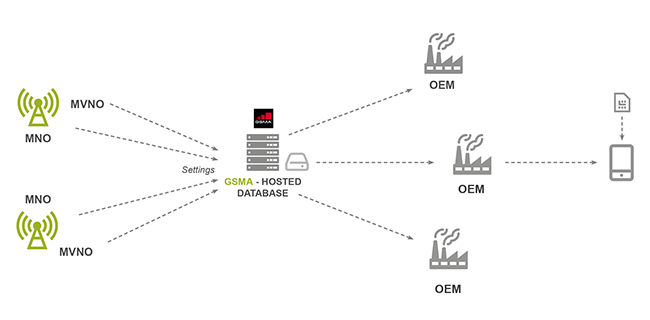
The increasing availability of high quality LTE (Long Term Evolution) networks brings the promise of much better technologies, and Voice over LTE and Voice over WiFi are just two of those. Unfortunately, if you’re someone that actually enjoys these technologies, you may be aware just how difficult it is to actually get them to work.
Why doesn’t VoLTE and VoWiFi just work?
In short, for your phone to access and utilise a carrier’s VoLTE or VoWiFi systems, it has to know quite a few settings. It isn’t just as simple as setting up an APN anymore, something which is mostly redundant because the carrier’s APNs are baked in to most modern phones these days.
There’s no centralised database of these settings and this makes it a bit harder to get your phone working on a carrier’s VoLTE or VoWiFi systems. The nature of these systems means that device makers and carriers have to collaborate to test and certify phones before these advanced networking features are available. In short, this means that unless you buy a phone from a carrier, you can almost guarantee that VoLTE and VoWiFi won’t work.
What’s GSMA doing?
The GMSA has taken note of this clunky process, and is now working with its partners to develop an open standard for delivering carrier features to more phones.
The GSMA’s wants to fix this by launching a “Centralised Device Settings Database.”
This online repository would be run by the GSMA, allowing carriers to upload universal device settings to enable these features on (theoretically, at least) any phone. When you insert a SIM card in a phone with support for this system, it will connect through an OEM system to the central device settings repository, and obtain the necessary settings to enable video calling, VoLTE, WiFi calling, and so on.
Will this work in Australia?
The short answer is no, not yet.
A number of OEMs and carriers are signing up overseas, including big names like Samsung and LG, Huawei and HTC, and carriers Vodafone, Verizon, AT&T and more. Notably, none of the Australian carriers are on board … yet.
Knowing how LTE certification is done by the carriers in Australia at the moment, though, there’s no guarantee that merely having the appropriate LTE-specific settings on your smartphone will actually allow it to work with your chosen carrier.
In Australia, at least, unless carriers have actually tested the device and confirmed that it works properly, and that important features like Emergency 000 dialing actually work, they won’t allow the phone to access these more advanced network features.
For popular handsets, this isn’t really an issue. Samsung’s Galaxy S8, for example, can be used on any of the three major carriers and VoLTE will work. VoWiFi works on Telstra (that I know of) and will probably work if it’s supported elsewhere. The carriers all sell this phone, and so even if you buy it outright or from overseas, it will work here without skipping a beat.
For less popular devices, or carrier exclusives, you can forget that level of compatibility. Google’s Pixel phones, for example, are only sold by Telstra (or outright). Vodafone and Optus don’t sell them, and as a result, don’t test them nor support them. Ultimately, this means Pixel phones won’t support VoLTE or VoWiFi on Optus or Vodafone unless those carriers choose to enable it.
Will this change?
Ultimately, it has to. VoLTE and VoWiFi are — today, at least — niche features. Most users don’t know about them, nor care. VoLTE is invisible to the user who’s not looking for it — superficially, all it does is make call setup times quicker.
However, it does more than that. It means your phone doesn’t need to drop to 3G to make a call, and given investment these days is in 4G coverage, there are plenty of areas you can get a reliable 4G signal and no 3G. Being able to make calls on 4G is important.
These features are almost becoming the new version of carrier lock-in, seen as exclusive features, and that shouldn’t be — these are standard networking capabilities that should, absent some compelling reason, be available to any handset which properly supports them. I should be able to use VoLTE on my Google Pixel regardless of the network I use.
Today I can’t. Tomorrow I’ll be able to, and so will you.
This is the kind of innovation that GSMA – as the trade association for the world’s mobile network operators — is working to facilitate. They’re not just about Mobile World Congress, you know.




Any updates for this story. Telstra has announced that they are planning on shutting down their 3g network mid next year. If that’s the case we will have to start buying phones from the carrier to access volte. Without 3g I won’t be able to make phone calls.
Any updates to this story? I need to have a iphone for wi-fi calling when i go abroad. It works will in all countries and with all carriers. So stupid that iphone locked ios is superior on wifi calling while open android is so locked in.
Hi.
I have an overseas Huawei mate 10 and switched to Telstra from Vodafone. However I lost VOLTE! Can’t believe it! That’s just ridiculous!
Any news on when this will be updated and carriers will participate in Australia?
Thanks
Nisar.
“The carriers all sell this phone, and so even if you buy it outright or from overseas, it will work here without skipping a beat.” That’s not true in my experience. You need to flash the carrier specific firmware for say Telstra for the phone to work on Telstra, and if the phone was bought overseas, this could be particularly problematic because the Customer Service Code (or CSC) in Samsung devices determines which countries’ standards the device is suited to and changing this is not for the faint of heart (like flashing alternate firmware) Even if you call up Telstra… Read more »
Re. 3G vs 4G coverage, it’s not entirely accurate to suggest that 3G is routinely unavailable in 4G areas. The vast majority of investment in a new site deployment is in site acquisition and capital works costs. Throwing in a few 3G NodeBs alongside the LTE kit is a marginal extra cost at best, unless equipment space is at a premium. If anything, you’re more likely to find the polar opposite scenario at the moment, especially in areas where it’s difficult for the carrier to gain access to upgrade their equipment (road and rail tunnels for example).
This is great news. In this day and age, with VoLTE and VoWIFI available, there is absolutely no reason why it isnt more open and accessible. The fact that I buy a phone from someone who isnt my carrier, and then I’m unable to use these features supported by the network and the phone, is pretty much anti-competitive behaviour.
Hope this comes of age soon.
I hate having to use the crappy Optus WiFi Talk app on my Pixel 2 XL. I never get call or message notifications and the app silently crashes at least once a day which means I can’t use it until I enter a PIN again. And half the time I don’t realise until my phone picks up a miniscule amount of reception in the house and gets a proper missed call SMS…
Very informative article Chris. I’ve bought the Hong Kong version of the Note 8 – but it won’t enable VoLTE on it. So maybe I’ll have to wait for Optus to sign up to this new standard.
What you might find there with the Note 8 is that if you flash it with the XSA version of the Austrailan firmware, it’ll probably start working on VoLTE here. The XSA Galaxy S8 works on VoLTE on any network.
Ahhh – thought of that. However the model I have is the 9500. Which has the Qualcomm chip. I don’t think the XSA firmware will work with it? Its meant for the Exynos chip I think?